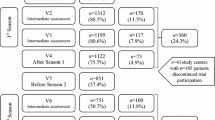Summary
The manifestation of rhinitic symptoms in 9 patients with grass pollen-induced rhinitis was studied during long term allergen exposure at physiological concentrations in the ‘Vienna Challenge Chamber’. Patients were pretreated with a single dose of azelastine (either 2.2mg orally or 0.28mg intranasally) or placebo. Nasal resistance was estimated by active anterior rhinomanometry every 15 minutes. Analysis of changes in nasal airways resistance demonstrated significant protection against allergen-induced nasal obstruction (p < 0.01) for azelastine administered by either route. The onset of action of treatment in relation to nasal obstruction was significantly more rapid for the nasal spray (135 minutes) than for the tablet (205 minutes) [p < 0.01] formulation. Similarly, the onset of effect derived from subjective assessment of symptom severity was markedly more rapid (60 minutes) after intranasal azelastine than after administration of the oral form (120 minutes). Tolerability of azelastine was good, with no side effects reported with either oral or intranasal therapy.
Similar content being viewed by others
References
Achterrath-Tuckermann U, Simmet T, Luck W, Szelenyi I, Peskar BA. Inhibition of cysteinyl-leukotriene production by azelastine and its biological significance. Agents and Actions 24: 217–223, 1988
Albazzaz MK, Patel KR. Effect of azelastine on bronchoconstriction induced by histamine and leukotriene C4 in patients with extrinsic asthma. Thorax 43: 306, 1988
Bisgaard H, Olsson P, Bende M. Effect of leukotriene D4 on nasal mucosal blood flow, nasal airway resistance and nasal secretion in humans. Clinical Allergy 16: 289–297, 1986
Casale TB. The interaction of azelastine with human lung histamine H1, beta and muscarinic receptor sites. Journal of Allergy and Clinical Immunology 83: 771–776, 1989
Cauna N, Hinderer KH, Weniges RT. Sensory receptor organs of the human nasal respiratory mucosa. American Journal of Anatomy 124: 1323–1328, 1969
Chand N, Diamantis W, Sofia RD. Antagonism of histamine and leukotrienes by azelastine in isolated guinea pig ileum. Agents and Actions 19: 164–168, 1986a
Chand N, Nolan K, Diamantis W, Perhach Jr JL, Sofia RD. Inhibition of leukotriene (SRS-A-mediated acute lung anaphylaxis by azelastine in guinea pigs. Allergy 41: 473–478, 1986b
Chand N, Pillar J, Diamantis W, Sofia RD. Inhibition of IgE-mediated allergic histamine release from rat peritoneal mast cells by azelastine and selected antiallergic drugs. Agents and Actions 16: 318–322, 1985
Corrado OJ, Gomez E, Baldwin DL, Clague JE, Davies RJ. The effect of nedocromil sodium on nasal provocation with allergen. Journal of Allergy and Clinical Immunology 80: 218–222, 1987
Devillier P, Dessanges JF, Rakotosihanaka F, Ghaem A, Bousley HA, et al. Nasal response to substance P and methacholine in subjects with and without allergic rhinitis. European Respiratory Journal 1: 356–361, 1988
Dockhorn FJ, Bergner A, Connell JF, Falliers CJ, Grabiec SV, et al. Safety and efficacy of loratadine (Sch-29851), a new non-sedating antihistamine in seasonal allergic rhinitis. Annals of Allergy 58: 407–411, 1987
Holmber K, Bake B, Blychert LO, Pipkorn U. Effects of topical H1 and 2 receptor antagonists on symptoms and local vascular reactions induced by nasal allergen challenge. Allergy 44: 281–287, 1989
Horak F, Jäger S. The Vienna Challenge Chamber — a new method of allergy exposition tests. Wiener Klinische Wochenschrift 99: 509–510, 1987
Howarth PH, Holgate ST. Comparative trial of two non-sedative H1 antihistamines, terfenadine and astemizole, for hayfever. Thorax 39: 668–672, 1984
Inoue Y. Basic studies on the antiallergic drug, 4-(p-chlorobenzyl)-2-[N-methylperhydroazepinyl-(4)]-1-(2H)-phthalazinone hydrochloride (azelastine). Nippon Ika Daigaku Zasshi 50: 371–378, 1983
Katayama S, Tsunoda H, Sakuma Y, Kai H, Tanaka I, et al. Effect of azelastine on the release and action of leukotriene C4 and D4. International Archives of Allergy and Applied Immunology 83: 284–289, 1987
Kemp GJP, Buckley CE, Gershwin ME, Buchman E, Cascio FL, et al. Multicentre, double-blind, placebo controlled trial of terfenadine in seasonal allergic rhinitis and conjunctivitis. Annals of Allergy 54: 502, 1985
Lenhard G, Gerhardt G. Azelastine, a new drug in the treatment of allergic rhinitis. New England and Regional Allergy Proceedings 9: 366, 1988
Meltzer EO, Storms WW, Pierson WE, Cummins LH, Orgel HA, et al. Efficacy of azelastine in perennial allergic rhinitis: clinical and rhinomanometric evaluation. Journal of Allergy and Clinical Immunology 82: 447–455, 1988
Miadonna A, Tedeschi A, Leggiere E, Lorini M, Folio G, et al. Behaviour and clinical relevance of histamine and leukotrienes C4 and B4 in grass pollen-induced rhinitis. American Review of Respiratory Diseases 136: 357–362, 1987
Middleton E, Ferriola P, Drzewiecki G, Sofia RD. The effect of azelastine and some other antiasthmatic and antiallergic drugs on calmodulin and protein kinase C. Agents and Actions 28: 8–15, 1989
Rajakulasingam K, Polosa R, Holgate ST, Church MK, Howarth PH. Comparative nasal responses to bradykinin, kallidin and des-arg9 bradykinin in non-rhinitic and atopic rhinitic subjects. Clinical and Experimental Allergy 20 (Suppl. 1): 57, 1990
Spector SL, Perhach JL, Rohr AS, Rackelefsky GS, Katz RM, et al. Pharmacodynamic evaluation of azelastine in subjects with asthma. Journal of Allergy and Clinical Immunology 80: 75–80, 1987
Walsh S, Robinson C, Howarth PH. The nasal effects of prostaglandin D2 in non-rhinitic and atopic rhinitic subjects. Abstract. Clinical and Experimental Allergy 20: 115, 1990
Weiler JM, Donnelly A, Campbell BH, Connell JT, Diamond L, et al. Multicentre, double-blind, multiple dose, parallel-groups efficacy and safety trial of azelastine, chlorpheniramine, and placebo in the treatment of spring allergic rhinitis. Journal of Allergy and Clinical Immunology 32: 801–811, 1988
Zechel HJ, Brock N, Lenke D, Achterrath-Tuckermann U. Pharmacological and toxicological properties of azelastine, a novel antiallergic agent. Arzneimittel-Forschung/Drug Research 31: 1184–1193, 1981
Author information
Authors and Affiliations
Rights and permissions
About this article
Cite this article
Horak, E., Jäger, S., Toth, J. et al. Azelastine in Pollen-Induced Allergic Rhinitis. Drug Invest 7, 34–40 (1994). https://doi.org/10.1007/BF03257397
Published:
Issue Date:
DOI: https://doi.org/10.1007/BF03257397




